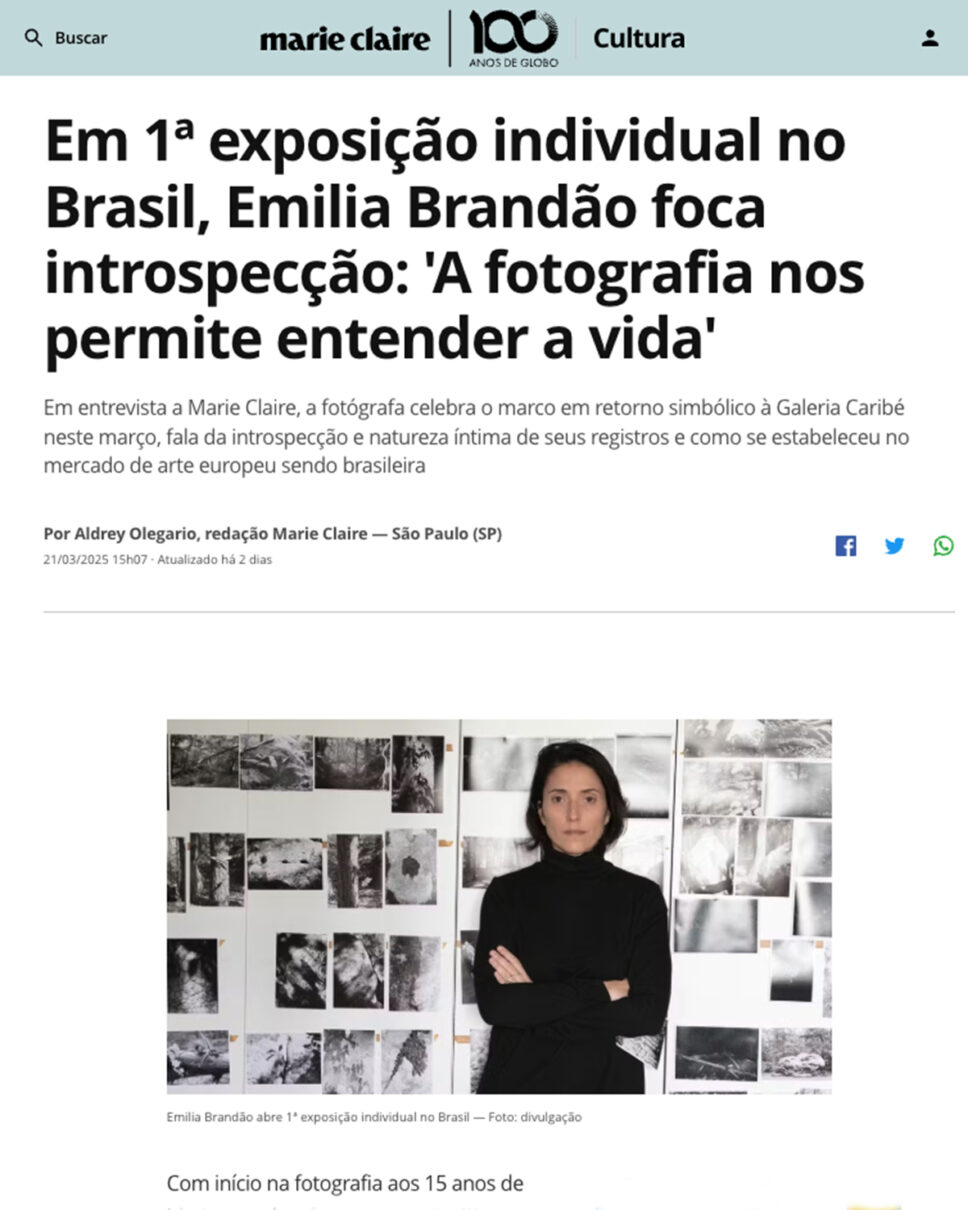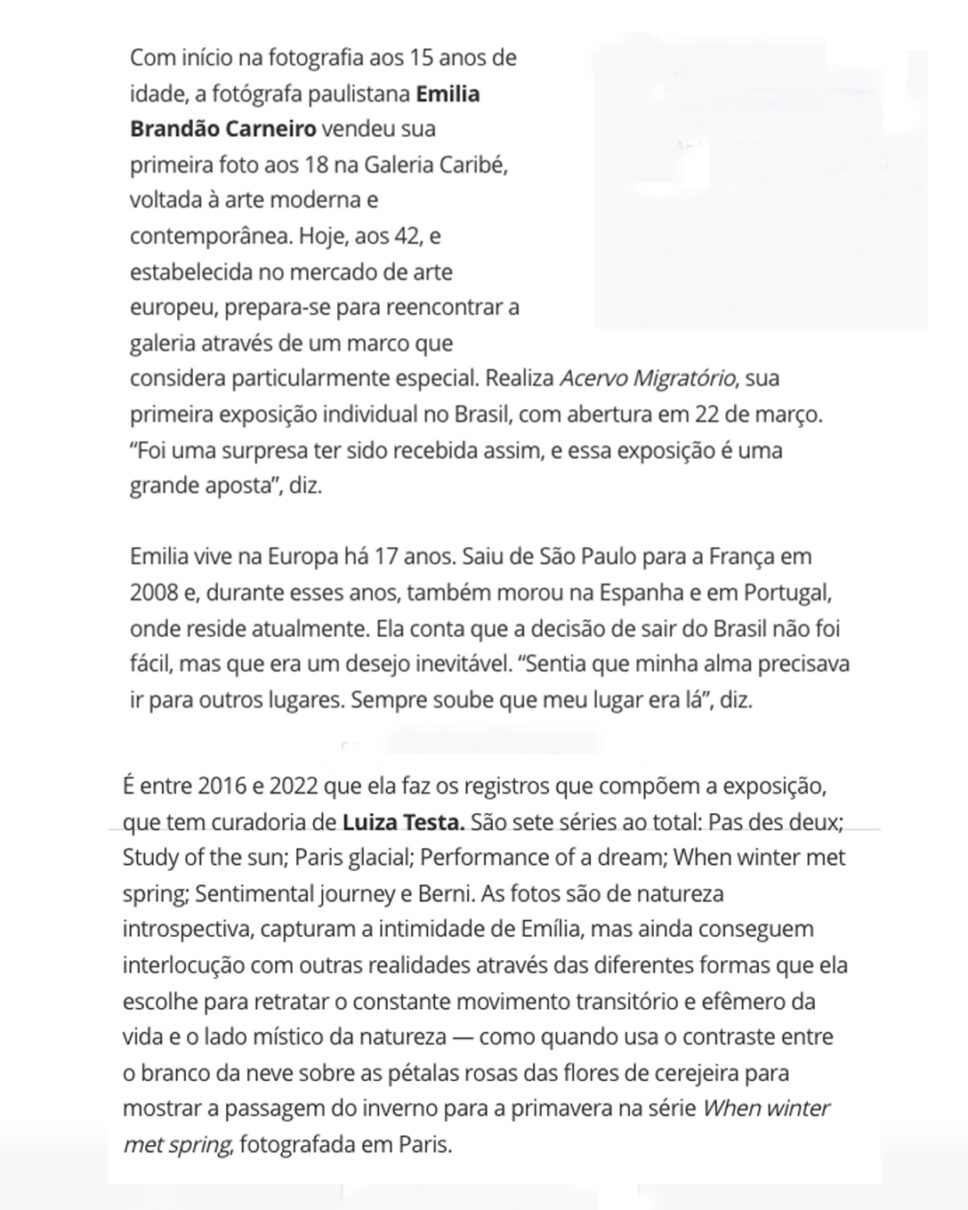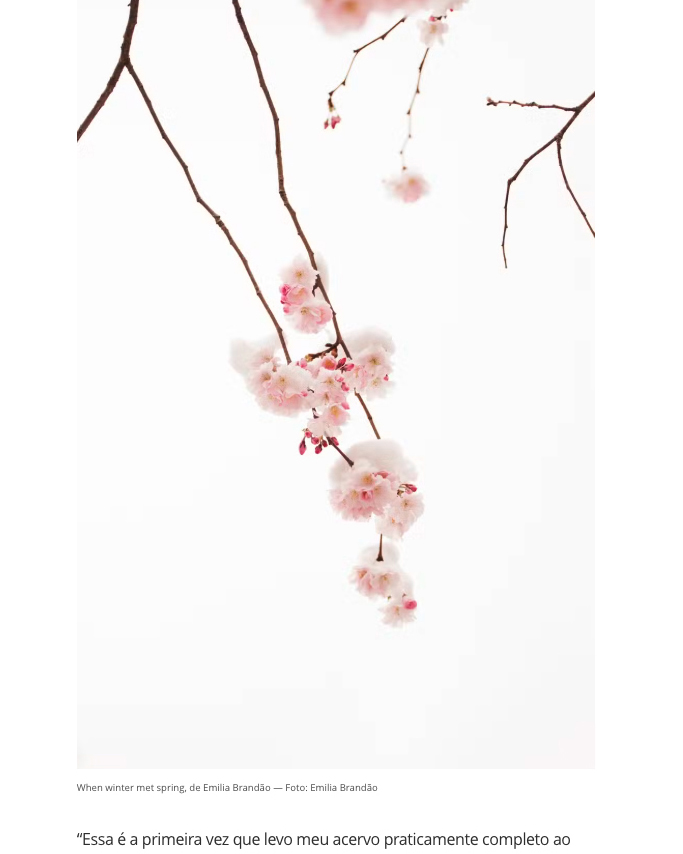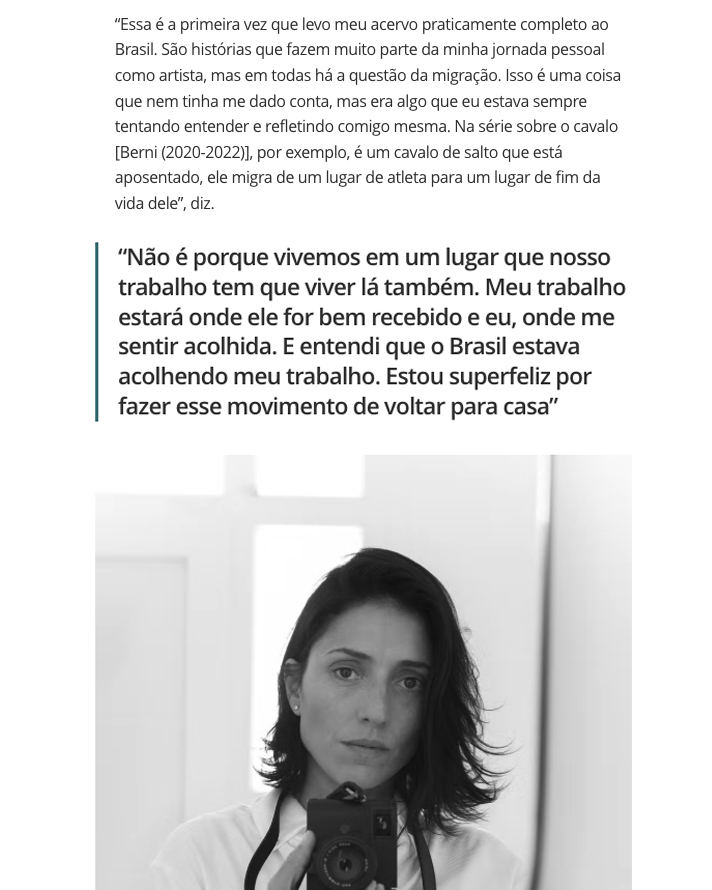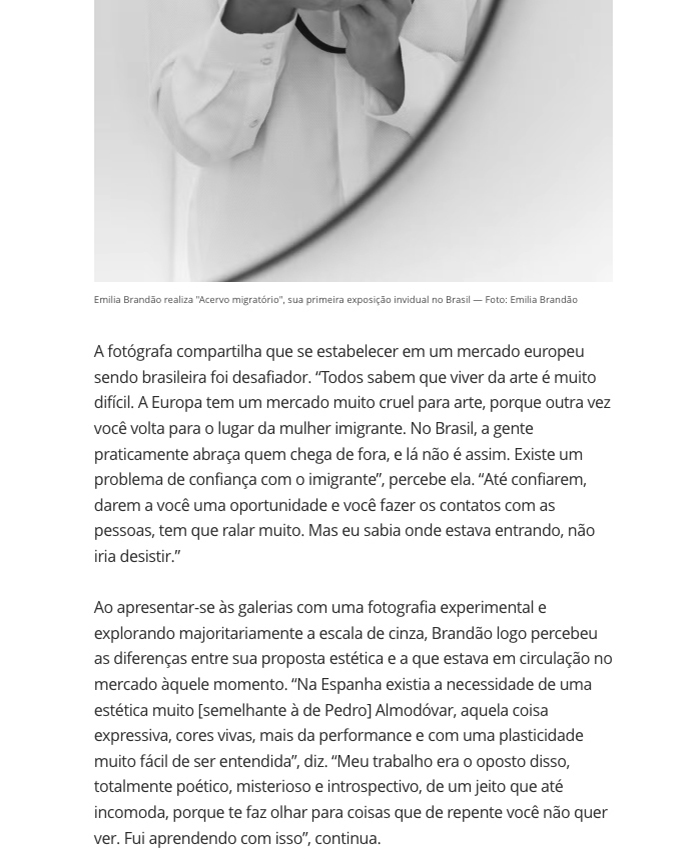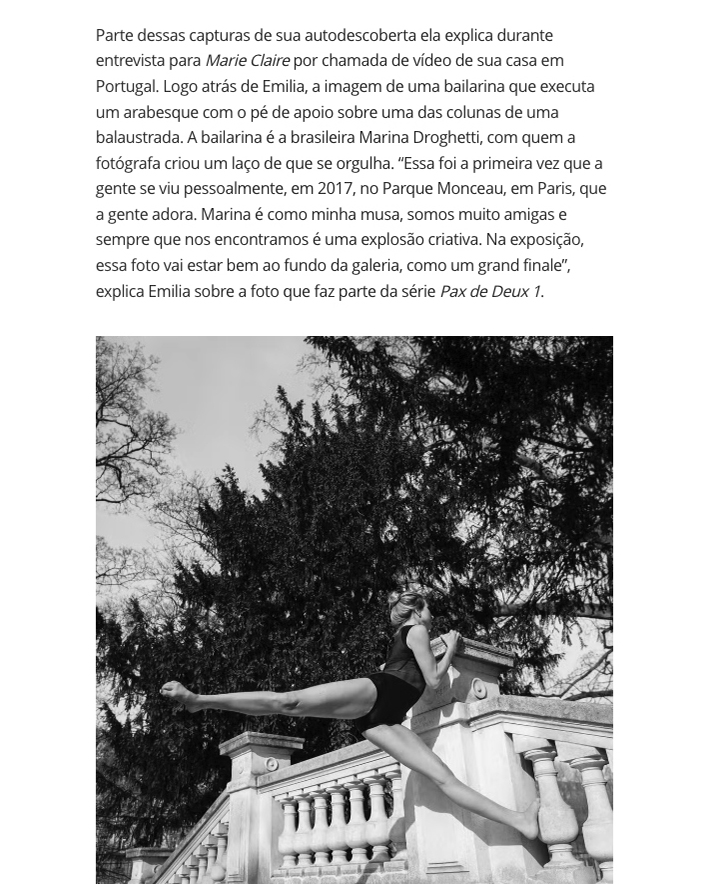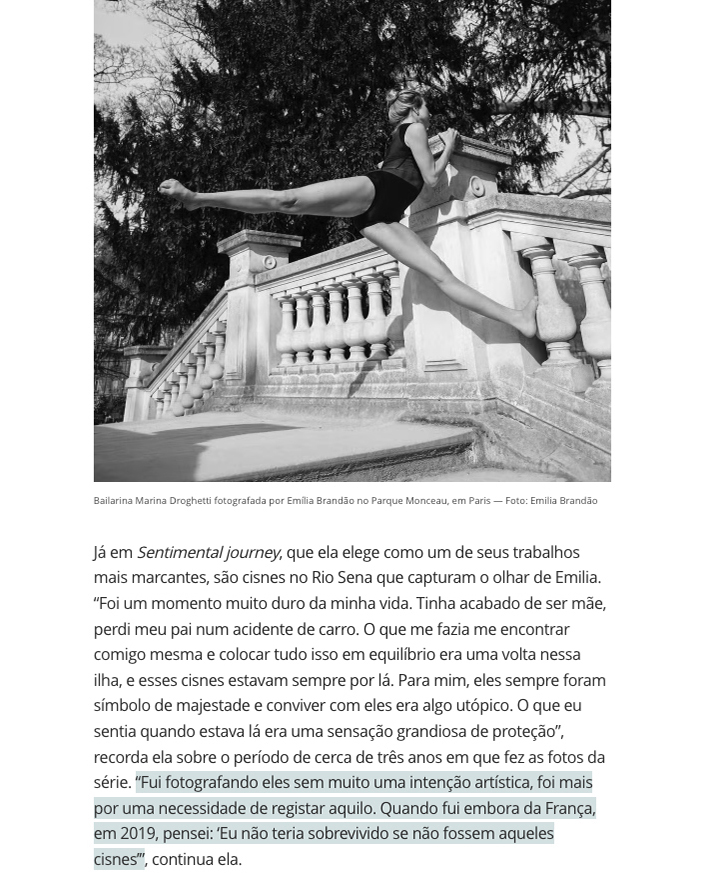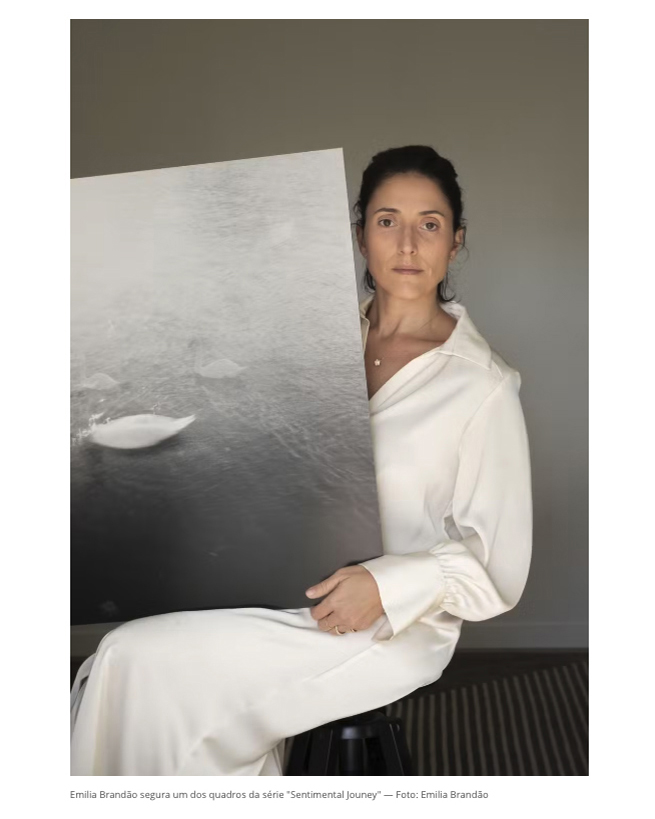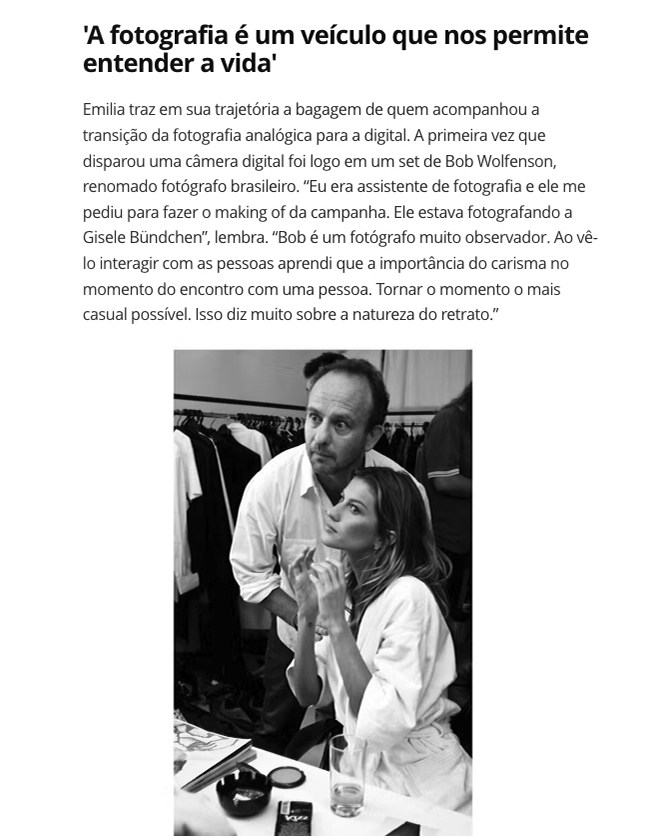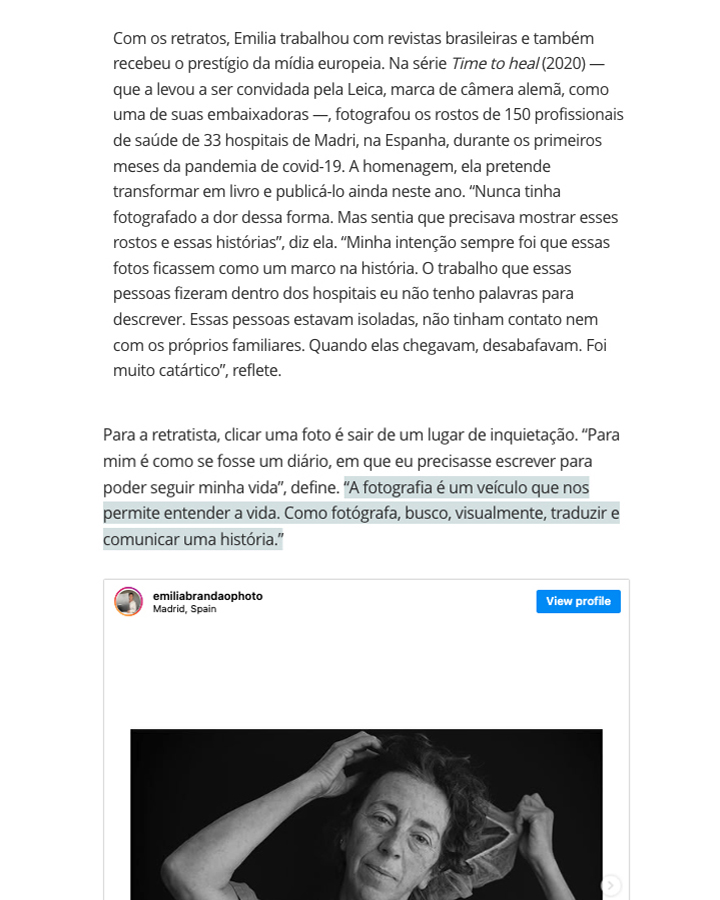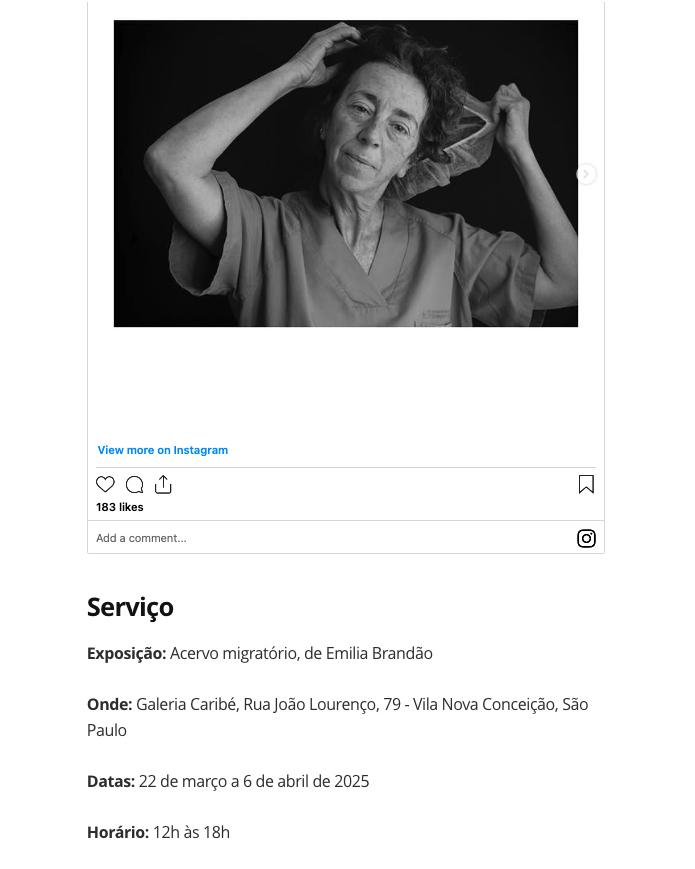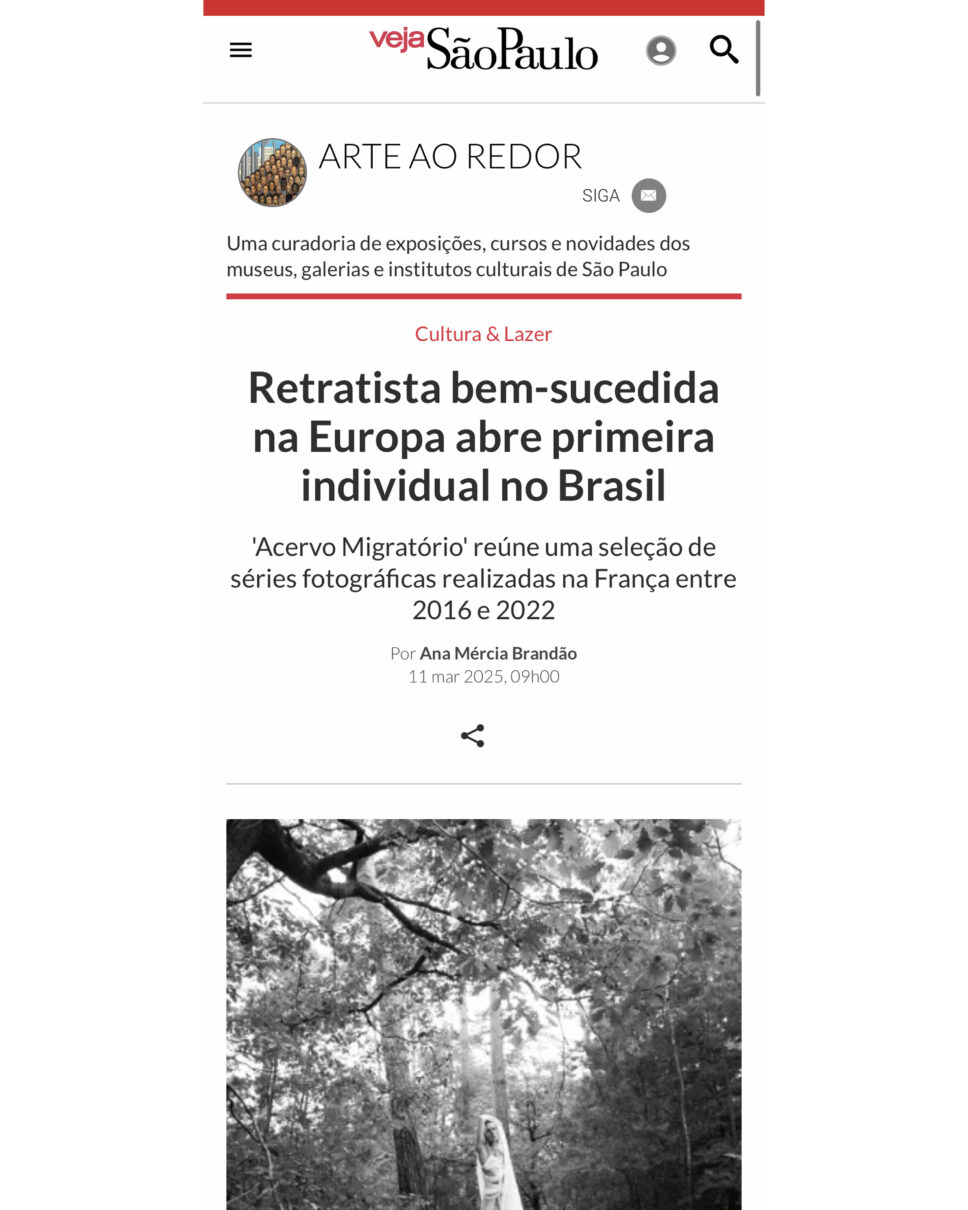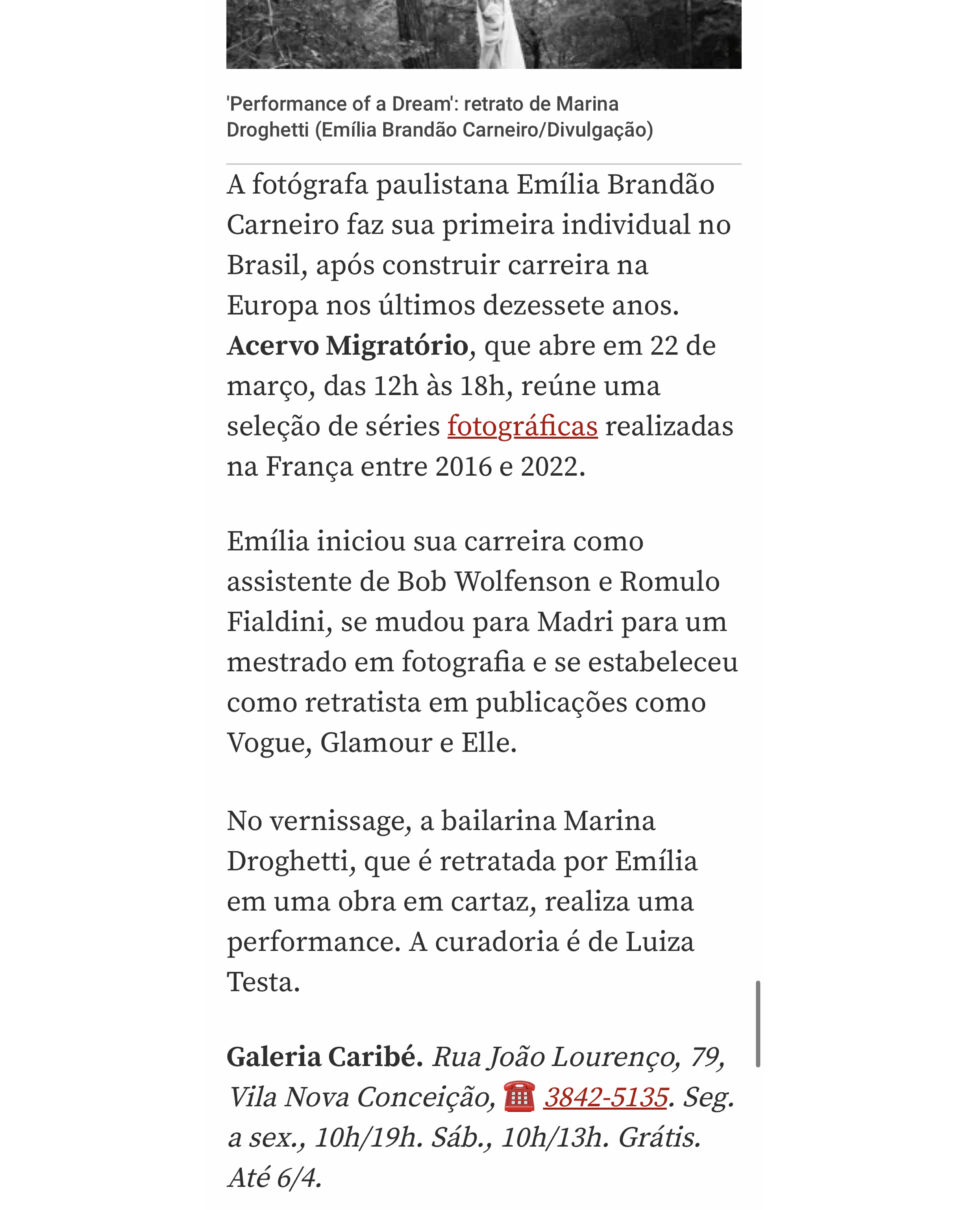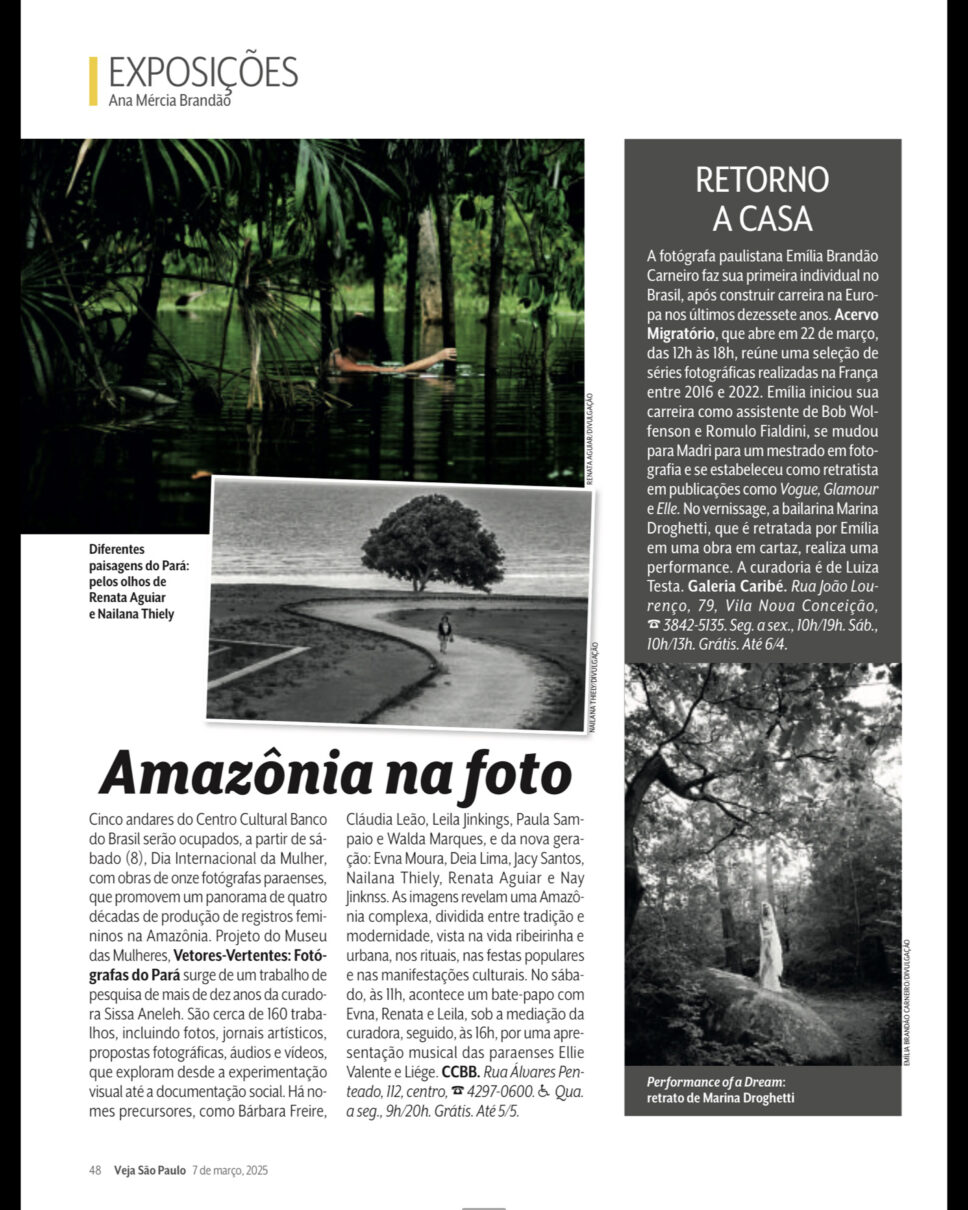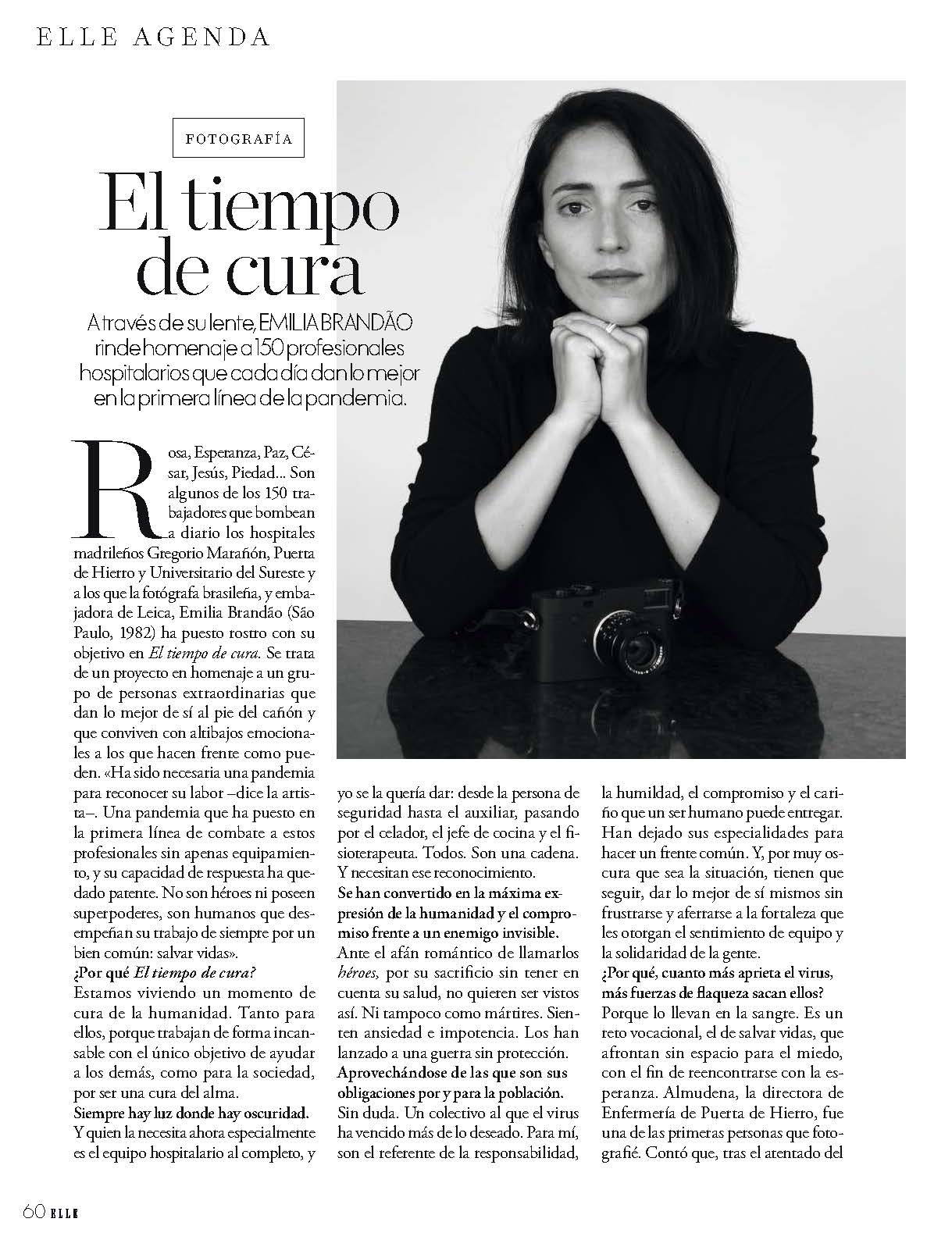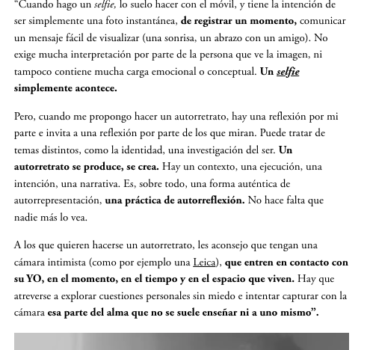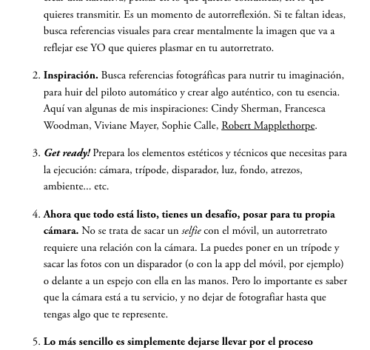PRESS
MARIE CLAIRE, BRAZIL
https://revistamarieclaire.globo.com/cultura/noticia/2025/03/em-1a-exposicao-individual-no-brasil-emilia-brandao-foca-introspeccao-e-trajetoria-como-imigrante-na-europa.ghtml
VEJA SP, BRAZIL
ELLE SPAIN

Here’s the revised translation with “El Tiempo de Cura” replaced by “Time to Heal”:
—
Time to Heal
Through her lens, EMILIA BRANDAO pays tribute to 150 hospital professionals who give their best every day on the front lines of the pandemic.
Rosa, Esperanza, Paz, César, Jesús, Piedad… These are some of the 150 workers who daily pump life into the Madrid hospitals Gregorio Marañón, Puerta de Hierro, and Universitario del Sureste, and whom Brazilian photographer and Leica ambassador Emilia Brandão (São Paulo, 1982) has captured with her lens in Time to Heal. This project honors a group of extraordinary individuals who give their all in the trenches and who face emotional ups and downs as best they can. “A pandemic was needed to recognize their work,” says the artist. “A pandemic that has placed these professionals on the front lines of battle with barely any equipment, and their response capacity has become evident. They are not heroes, nor do they possess superpowers; they are humans doing their usual jobs for a common good: saving lives.”
Why Time to Heal?
We are living in a moment of healing for humanity. For both them, as they tirelessly work with the sole aim of helping others, and for society, as it serves as a healing of the soul.
There is always light where there is darkness.
And those who especially need it now are the entire hospital team, and I wanted to give it to them: from the security personnel to the aides, including the orderlies, the head chef, and the physiotherapist. Everyone. They are a chain. And they need that recognition.
They have become the ultimate expression of humanity and commitment against an invisible enemy.
In the romantic urge to call them heroes for their selfless sacrifice without regard for their health, they do not want to be seen that way. Nor as martyrs. They feel anxiety and helplessness. They have been thrown into a war without protection.
Taking advantage of what are their obligations for and to the population.
Undoubtedly. A collective that the virus has overcome more than desired. For me, they are the benchmark of responsibility, humility, commitment, and the love that a human can give. They have left their specialties to form a common front. And no matter how dark the situation is, they must continue to give their best without getting frustrated and cling to the strength that the team spirit and the solidarity of the people provide them.
Why do they draw more strength when the virus tightens?
Because it’s in their blood. It’s a vocational challenge, that of saving lives, which they face without space for fear, in order to reconnect with hope. Almudena, the nursing director of Puerta de Hierro, was one of the first people I photographed. She said that after the 11M attack, to keep going, she drew strength from anger. It was horrifying, yes, but it happened in hours. Now this is like a tsunami, progressive and sustained, very, very long, and no matter how well prepared they are in the hospitals, it exceeds imaginable limits. It never ends.
So where do they find their grit?
In the love for others. That which was anesthetized for a time and that they now experience on the front lines. They are being vulnerable.
Why do you think it’s so hard for us to show weaknesses?
There’s a teacher, Brené Brown, who challenges you to be brave and, therefore, to practice vulnerability. Contrary to popular belief, they are inherent; you cannot have one without the other. A person’s courage is measured by their ability to be vulnerable. They now live in the arena: with uncertainty, risks, and fierce emotional exposure. They get up every morning and choose courage over comfort and their families, even if this means stumbling, suffering, and sometimes failing. They have the guts to try, even when they cannot control the outcome. Right now, they are in action, keeping a cool head to avoid mistakes and without time to connect with the stillness inside the storm. When they do the latter, they will be emotionally and physically out of the game.
They are the only hope that the sick have of winning the battle.
And it’s an enormous responsibility that they live with a heartbreaking strength. They are exhausted, though not defeated, and they are the eyes and voice of all those who cannot hold the hand of their loved ones. They embrace that last caress, that last breath. Imagine hearing the beep of the oxygen supplying air to a patient’s lungs, feeling the pulse drop to 20, and knowing what the outcome will be. And one of the nurses there, unable to do more and at risk of contagion, removes her gloves and touches him so he doesn’t die alone. Suddenly, the heartbeat begins to rise. And he is saved. Sometimes, to keep living, all it takes is the warmth of physical contact.
The response from everyone is titanic. What do they ask of us in return?
To be responsible, nothing more. Their vaccine is us. They do more than is asked of them. If we want to survive in the future, we have to remain united as a society. So, out of respect, let’s fulfill our part.
Text: Claudia Saíz
EL MUNDO

EL MUNDO digital

by Paola de Francisco
4/11/2020
Time to Heal: A tribute to our healthcare workers for their fight against the pandemic
Tears, lost gazes, flashes of frustration, grimaces of despair… Photographer Emilia Brandão captures the collapse caused by Covid, but not the collapse of a healthcare system; rather, the collapse of those people we call heroes.
During the first wave of the pandemic, our applause broke the silence of confined and frightened cities. It was our way of cheering each other on and encouraging healthcare workers in the fight against the coronavirus. The months of March and April were a succession of reports of deaths in nursing homes, thousands of daily admissions, and hundreds of fatalities, with ICUs overwhelmed…
In light of this situation, Brazilian photographer Emilia Brandão picked up a camera, with the support of Leica and the NGO Doctors of the World, and ventured into hospitals to portray the heroes in scrubs who were on the front lines of the battle. “It was my way of giving back to this city and this country something of what they have given me,” she explains. This is how the exhibition Time to Heal: Portraits of Healthcare Professionals in the Battle Against Covid-19 was born, which will be held at the Leica Gallery on José Ortega y Gasset Street 34 until November 12.
The author’s goal was to convey what was happening during the pandemic and healthcare collapse through the hospital workers. “I understood that this was the best place because it was where the coronavirus had leveled everyone.” From the cleaning lady to the director, no one escaped the consequences of a virus that they did not know how to stop. They all felt fear, despair, frustration, pain, and exhaustion…
In front of the lens, 150 professionals from the Gregorio Marañón, Puerta del Hierro, and Sureste hospitals broke down, one by one. “I wanted to offer them a place of rest and tranquility, where they could feel comfortable. I thought that this way they would tell me how it was going, but I never thought that what they had inside was that,” Brandão says, with teary eyes and a voice choked with emotion as she looks at the 30 portraits on display. “The news talked about the collapse of the healthcare system, but the ones collapsing were the people.”
“WE ONLY DID OUR JOB”
Healthcare workers state that if they were heroes, they would have superpowers and there would not have been a shortage of beds, medication, or oxygen, emphasizing that “we only did our job.” This was reiterated by Dr. José Eugenio Guerrero Sanz, head of the ICU at the Gregorio Marañón Hospital in Madrid, when he accepted the Princess of Asturias Award for Concord on behalf of all healthcare workers on October 16.
Dr. José Félix Hoyo, president of Doctors of the World, also stated this during the presentation of the exhibition Time to Heal. And Emilia Brandão repeats it: “They are just humans, not heroes. People who made an enormous effort.”
https://www.elmundo.es/madrid/2020/11/04/5f8d4c8021efa0a8388b45a5.html
VOGUE SPAIN

From ‘Selfie’ to Self-Portrait: 5 Tips for Photographing Yourself with Artistic Intent
Emilia Brandão, Leica ambassador photographer, shares her personal techniques for elevating her self-portraits to a level of excellence
By Vogue for Leica
November 27, 2020
“I understand selfies and self-portraits as ‘similar’ photographs because the subject of both is oneself as the main focus of the composition, but when you delve deeper into it, there are many fundamental characteristics that distinguish them,” explains Brazilian Leica ambassador photographer Emilia Brandão. She is here to share with **Vogue España** the reflections and tricks that work best for her in raising the quality of her work.
In Emilia Brandão’s words:
“When I take a selfie, I usually do it with my mobile phone, and it’s meant to be simply an instant photo, to capture a moment, to communicate an easily visualized message (a smile, a hug with a friend). It doesn’t require much interpretation from the viewer, nor does it contain much emotional or conceptual weight. A selfie simply happens.
But when I intend to create a self-portrait, there is reflection on my part and an invitation for reflection from those who look at it. It can address different themes, such as identity or an exploration of being. A self-portrait is produced, it is created. There is context, execution, intention, and narrative. It is, above all, an authentic form of self-representation, a practice of self-reflection. It doesn’t have to be seen by anyone else.
For those wanting to create a self-portrait, I advise having an intimate camera (such as a Leica), connecting with your SELF in the moment, time, and space you live in. You should dare to explore personal issues without fear and attempt to capture with the camera that part of the soul that is not usually shown, even to oneself.”
Tips to Improve Your Photography:
1. Jot down your ideas. Start to contextualize your thoughts, create a narrative, and think about what you want to communicate and convey. It’s a moment of self-reflection. If you’re lacking ideas, seek visual references to mentally create the image that will reflect the SELF you want to portray in your self-portrait.
2. Inspiration. Look for photographic references to nurture your imagination, to escape the autopilot mode, and create something authentic, infused with your essence. Here are some of my inspirations: Cindy Sherman, Francesca Woodman, Viviane Maier, Sophie Calle, Robert Mapplethorpe.
3. Get ready! Prepare the aesthetic and technical elements you need for execution: camera, tripod, remote shutter, light, background, props, atmosphere, etc.
4. Now that everything is ready, you have a challenge: posing for your own camera. It’s not about taking a selfie with your mobile; a self-portrait requires a relationship with the camera. You can put it on a tripod and take photos with a remote (or with your mobile app, for example), or hold it in your hands in front of a mirror. But the important thing is to know that the camera is at your service, and don’t stop photographing until you have something that represents you.
5. The simplest approach is to simply go with the creative process. Improvise, let yourself feel, and keep photographing until you capture a version of yourself that you want to carry with you in your story.
https://www.vogue.es/living/articulos/del-selfie-al-autorretrato-consejos-leica-fotografia-camaras
ARTNET
The photography collective South.Southwest has been on an ambitious mission to create a new canon of Latin American photography. The group, which formed several years ago under the patronage of the camera company Leica, brings together photographers from Brazil to Spain, including Sebastián Liste, Christina de Middel, Álvaro Ybarra Zavala, Laura León, Jesús Rocandio, Adriana Zehbrauskas, Stephen Ferry, Tomás Munita, and Emilia Brandão.
Though professional work of these photographers ranges from documentary and reportage to editorial, the collective’s output, has a more singular intent: to capture a poetic and expressly artistic vision of Latin American identity. Now, a selection of the collective’s works are being revealed to the public for the first time in an eponymous gallery exhibition curated by Irakli Megre and Isabelle Thul at Berlin’s re|space gallery.
The myriad landscapes, peoples, and animals captured in these images offer glimmers and glimpse of the boundlessness of Latin American art—pop culture abuts folklore, the vibrancy of youth plays out against ancient terrains. The intimate connection between Latin American people and nature is perhaps the common thread shared between these images, which alternately complement and contradict one another, creating a nuanced portrait of a global community. In one corner, American photographer Stephen Ferry’s raucous and raw color images of intimacy and celebration juxtapose the cinematographic scenes carefully composed by Spanish artist Cristina de Middel.
What’s more, the exhibition is also a unique opportunity for collectors of photography. Every work in the exhibition comes to sale directly from the artists and each print is unique—so the buyer will be the sole proprietor of the work. South.Southwest is intended as an ongoing project and the sales from the exhibition will fund future projects.
See images of “South.Southwest” below.

CONDÉ NAST TRAVELER
Time to Heal: An Exhibition Portraying Healthcare Workers in Madrid
The work of Emilia Brandão is a tribute to the healthcare community, which today receives the Princess of Asturias Award for Concord 2020.
By Arantxa Neyra
October 16, 2020
Until March 2020, Brazilian Emilia Brandão photographed football players, actors, and musicians for various lifestyle publications across Europe and South America. But that “lifestyle” changed all of us (Europe, South America, and the rest of the planet) overnight, and it prompted her, “who had never had that journalistic side,” to embark on a direction she had never taken.
She had recently settled with her family in Madrid, an old and beloved city where she had lived years before and considers her second home. However, this time, the Madrid that welcomed her was not the one she had fallen in love with—noisy, chaotic, lively, and sometimes frustrating—but a very different city. It was one shut tight, threatened and powerless, sad and scared, living 24 hours with goosebumps and a heavy heart.
That lethargic city and such a unique, historic moment led her to a “process of deep introspection,” “awaking a side that had been asleep,” realizing that “we are all interconnected with our actions” and beginning a search to discover what “the virus wanted to teach us.”
“I felt the urge to do something for others, and since the only thing I know how to do is portraits, I wanted to applaud and value everything the healthcare personnel were doing for us,” Brandão explains.
From ambulance drivers to pulmonologists, from orderlies to surgeons, from ICU cleaners to the doctor interviewed on television, everyone was invited over four days between April and May, when the pandemic in Spain was at its peak, to three major hospitals in Madrid (Puerta del Hierro University Hospital, Gregorio Marañón Hospital, and Southeast University Hospital) during their scarce moments of rest between their long shifts to sit in front of her camera.
Some broke down, others collapsed, some were left speechless, or shared with Emilia something they had not dared to tell anyone else.
**Time to Heal** is the result of a selection of that work: 150 stories, 150 people who fought on the front lines against the virus, who passed, one by one, through an improvised studio to be photographed, wrapped not in a superhero cape as we insisted on seeing them, but in a cloak of fear, impotence, and social service: of humanity.
Pain, frustration, exhaustion, sleeplessness, despair… all translated into swollen dark circles, neglected gray hairs, lost gazes, or tears, which have been captured in these beautiful and powerful black-and-white images, witnesses to a time we wish to forget and a labor we will never forget as a tribute to that entire healthcare community, which today receives the Princess of Asturias Award for Concord 2020 in Oviedo.
Paradoxically, as the mother of two young children and a husband with asthma, at a time when less was known about how the virus was transmitted, Emilia felt that “something” was protecting her: “I was working in favor of the virus; I knew it was a duty, and that’s why I felt calm.”
As she walks past the collection that composes the narrative and recalls each of the moments she captured, Emilia cannot control her emotions, nor can José Félix Hoyo, president of Doctors of the World, an NGO actively involved in supporting Spanish hospitals during the pandemic, nor Dr. Jesús Millán, head of Internal Medicine at Gregorio Marañón Hospital in Madrid (and one of those portrayed), who were present at the exhibition’s presentation at the Leica Gallery in Madrid, where it will be on display until November 12.
**Time to Heal** will likely continue traveling to other uncertain destinations, just like all of us. In the meantime, Emilia continues camera in hand, ready to stay committed to the project, “shooting” wherever it’s needed.
RTVE TELEDIARIO 1

https://www.rtve.es/play/videos/telediario/21-horas-13-11-20/5713722/?t=42m01s
por Carlos del Amor
RADIO RNE “El Culturódromo”

CADENA SER

Sadness, Pain, Despair, Exhaustion, and Helplessness: What the Photos Captured During the Pandemic Conveyed About 150 Healthcare Professionals in Madrid
A colorless gallery filled with emotion, recognizing those who continue to heal and care for us.
María Manjavacas
Cadena SER 03/11/2020 – 16:48
Madrid
Conducted during March and April 2020, **Time to Heal**, as the exhibition is called, is a tribute to the healthcare professionals facing an invisible enemy on the front lines. It is a personal project by Brazilian photographer Emilia Brandão, who is based in Madrid. “In mid-March in Madrid, my adopted city, my life, like that of the rest of humanity, changed radically due to Covid. While I was confined at home with my family, I felt an urgency to help and portray the heroes fighting on the front lines. I believe a portrait has the power of applause, and I felt they needed this recognition. I wanted to put faces and names to them, to create memories for some of the people who have been closely involved in the fight against the virus,” explains the photographer.
“The Worst I’ve Ever Experienced”
Inés García Calvo, an emergency nurse at Gregorio Marañón Hospital in Madrid, says this and repeats it. “When I started studying, AIDS was just beginning, and we were all involved in the research; no one knew what it was until it was identified, and I have never been so scared in my life. And more than fear, it was desperation,” recounts Inés, recalling one of her worst moments in the emergency waiting room on a day when they received 300 patients when the capacity was only 60. “They were sitting in chairs, and we couldn’t take them anywhere. They looked at you with such desperation,” Inés says.
Another colleague, Esther Monje, a nursing assistant, remembers the worst moment of her career when she saw a patient die in her arms because the family couldn’t be with him due to Covid protocols.
Elisa Castreño is the head housekeeper at Gregorio Marañón, coordinating cleaning services. She worked in Iraq when the war broke out and recalls that experience as much worse. “In war, you can have some bad hours, but then there are moments when you can hold on to something, embrace someone. With Covid, you can’t. You try to keep your distance for fear of contagion. This bug has left us without human warmth, which I miss so much.”
Time to Heal
To take the photos for the exhibition, a photography studio was set up for several days inside each of the three Madrid hospitals: Puerta del Hierro in Majadahonda, Gregorio Marañón, and Southeast University Hospital. “While they worked days and hours without rest, without time or energy to process everything that was happening to them internally, I offered them a pause, a chair under my light to get to know them and listen to how they felt. By inviting them to a moment of tranquility, many connected with their emotions for the first time since the beginning of the pandemic. Far from the heroic image they carried, I was able to see closely the vulnerable nature of these human beings who heal and care for others,” explains Emilia Brandão. The photographer shares that the goal of this project is to portray the hospital teams who are fighting and sacrificing their lives to save and heal thousands of people affected by Covid. The exhibition can be visited at the Leica Gallery in Madrid until November 12.
https://cadenaser.com/programa/2020/11/03/la_ventana/1604419336_649690.html
GLAMOUR BRASIL

Photographer Captures Professionals on the Front Lines Against Covid-19 in Madrid
“Time to Heal” Project by Brazilian Emilia Brandão Went Through 3 Hospitals and Portrayed Cleaning, Administrative, Medical, and Nursing Teams
By Testimony to Stefani Sousa; Photos by Emilia Brandão
05/05/2020
In an interview with Glamour, Brazilian photographer Emilia Brandão, 37, shares details of her days photographing healthcare professionals who are on the front lines against the coronavirus in hospitals in Madrid, Spain. In the city where she lives and is confined with her husband and two children, the photographer discovers experiences of love, struggle, and hope in the **”Time to Heal”** project. Understand more below:
“Confined at home since the beginning of March, I felt I needed to step out of my comfort zone and document where the war is happening. It was then that, at the invitation of Leica, a professional camera brand, I decided to provide a historical record for those working on the front lines and offer a loving perspective for these people who are in great need of affection.
I was expecting the professionals to talk about things at the hospital, but we went much deeper. It was a very transformative experience. Three hospitals in Madrid opened their doors, and I had the honor of photographing 150 people, from doctors and nurses to cleaning and administrative staff.
I thought I was prepared for stories of life in the hospital, about death and illness, but I was surprised by narratives of personal sacrifices made by healthcare professionals. This overwhelmed me.
There was a pattern during the sessions. The healthcare professionals arrived excited about the photos, with smiles on their faces, but that energy faded when they were alone with me. The intimacy and trust between us were very special, and they began to share their stories.
Every day, exhausted, doctors and nurses face long shifts of 12 to 16 hours of daily work. They are emotionally and physically drained, not just because of the work they do, but because of everything they face in dealing with the situation.
We call them heroes, but talking with them made me understand that this word was also causing them immense stress. No matter how extraordinary the work they are doing, it is clear that they are close to collapse.
CULTURA INQUIETA

Photographer Emilia Brandão Captures Healthcare Professionals in the Battle Against Covid-19
By Juan Yuste
October 9, 2020
Brazilian photographer and Leica ambassador, Emilia Brandão, presents her project TIME TO HEAL: Portraits of Healthcare Professionals in the Battle Against Covid-19 at Leica Gallery Madrid.
The exhibition is part of the cultural proposals of Leica Gallery Madrid and serves as a tribute to healthcare workers who will be recognized on October 16 in Oviedo with the Princess of Asturias Award for Concord 2020.
Emilia Brandão began her photography journey in 2000 with an old camera belonging to her father. She set up a photography lab and has not stopped photographing since.
Her passion lies in capturing people, portraits, and the individual light that is imprinted in a photograph.
Her career in film, specializing in cinematography, fueled her passion for still photography, and since 2008, she has been dedicated to photography professionally.
In mid-March 2020, Madrid, her city of adoption, was experiencing the most challenging weeks of the COVID-19 crisis. After weeks of confinement with her family, she decided to support those who were suffering the most from the crisis by portraying healthcare professionals, creating this project: **TIME TO HEAL**.
Three hospitals in Madrid dedicated exclusively to COVID-19—Hospital Universitario Puerta del Hierro, Hospital Gregorio Marañón, and Hospital Universitario del Sureste—generously opened their doors to her. There, she set up a photography studio and had the honor of photographing 150 healthcare professionals from all departments of the hospitals.
Photographer Emilia Brandão explains that the main objectives of this project have been to honor the professionals fighting in this battle and to provide them with a safe space to rest and breathe, even if just for a few minutes, as they knew they were on the brink of collapse:
“The intimacy and trust that developed between us were very special, and they began sharing their stories with me—things they had often not told their partners or even themselves. They found themselves emotionally and physically exhausted, not only from the work but from everything that comes with facing a pandemic. We, and the media, called them ‘heroes,’ yet while I photographed and spoke with them, I came to understand that this word, which can imply having superpowers, was causing them enormous stress. Because they are human, and no matter how extraordinary the work they were doing, it was clear that they also needed to heal to move forward.”
TIME TO HEAL, by Emilia Brandão
Leica Gallery Madrid
Until November 12, 2020
CONDÉ NAST TRAVELER

THE SENTIMENTAL JOURNEY OF EMILIA BRANDÃO CARNEIRO
You may not know that F&deO is the first exhibition space focused on researching female art. If you haven’t done so already, you can visit it until July 30 in the best way: through **Sentimental Journey**, the beautiful and poetic exhibition by Brazilian photographer Emilia Brandão Carneiro.
Born in 1982 and a Leica ambassador in 2020, Brandão has exhibited not only in our country but also in Germany, Brazil, and France. Her series Sentimental Journey was awarded this year with an Honorable Mention by the 18th Julia Margaret Cameron Award for Women Photographers.
The photographs you will see at F&deO, taken in black and white, are a series of portraits of swans on the Seine in Paris. Each moment, each portrait, challenges the conventional image of such a photogenic bird and, from a poetic and somewhat unsettling perspective, establishes a direct relationship with the viewer. It’s the kind of experience that captivates and provokes thought.
https://www.traveler.es/articulos/planes-para-el-fin-de-semana-15-16-y-17-de-julio
ELLE SPAIN

Until July 30, we can see at the F6deO Gallery the exhibition Sentimental Journey, a collection of photographs by Brazilian Emilia Brandão Carneiro, which focuses on portraying swans on the Seine in Paris. However, the author wants to move away from stereotypes, and we see unusual images; an ugly and twisted swan, for example. But nothing alarming, and that is Brandão’s specialty—knowing how to capture everything that feels familiar while also unexpected: food, friends… all with a romantic, charming, and special aura.
CULTURA INQUIETA

Photographer Emilia Brandão Carneiro Captures the Intimacy and Dreamy Romanticism of the Seine River
By Luiki Alonso
July 18, 2022
Mental flashes and sentimental slides succeed each other, blurred by the softness of their strokes, which, faded at the edges of their shapes, evoke the daydreaming that represents an intimate romanticism not tinged with pink but with grays.
When we think of romance in all its meanings, forms, and manifestations, many of us conjure up the common scene of some of the most famous corners of Paris, the capital of love.
In Sentimental Journey, a series by Brazilian photographer Emilia Brandão Carneiro (1982), the artist showcases her delicate sensitivity and celebrates the romantic by working toward the evolution and transformation of the art world to imprint a feminine essence free from complexes, prejudices, and preconceived ideas.
Black-and-white photographs depict swans on the Seine. While it may sound somewhat cliché, what makes Brandão’s work fascinating is that the captures show something different from what we would expect.
For example, a swan that twists, with an ugly, somewhat troubled appearance, challenges the conventional image we associate with these graceful birds. We also notice, of course, the “Brandão signature” in the usual tenderness and generosity of her gaze (which may have caught the attention of the curators at PhotoVogue, who awarded four images from the series).
Emilia Brandão Carneiro’s art can be described as “shamelessly romantic.”
In Brandão’s work, we can see sunlight poetically filtered through the silhouettes of trees, blurry faces in a pensive mood, flowers, clouds, nudes, etc.
Some images are so beautiful and magical that they make us blush because we sometimes forget how radical it is to be romantic in the times we live in. Brandão’s art exists to challenge preconceived notions. It is deeply committed and human. It is, in fact, quite intelligent.
In this exhibition, the Brazilian who adopted Madrid as her home conveys a sense of familiarity. In a world obsessed with novelty, Brandão presents images that find their value in representing what we already know.
The F&deO Gallery in Madrid, the first exhibition space focused on researching female-centered art, opened the doors to **Sentimental Journey** on June 16, an individual exhibition of the acclaimed and dreamy photographer.
